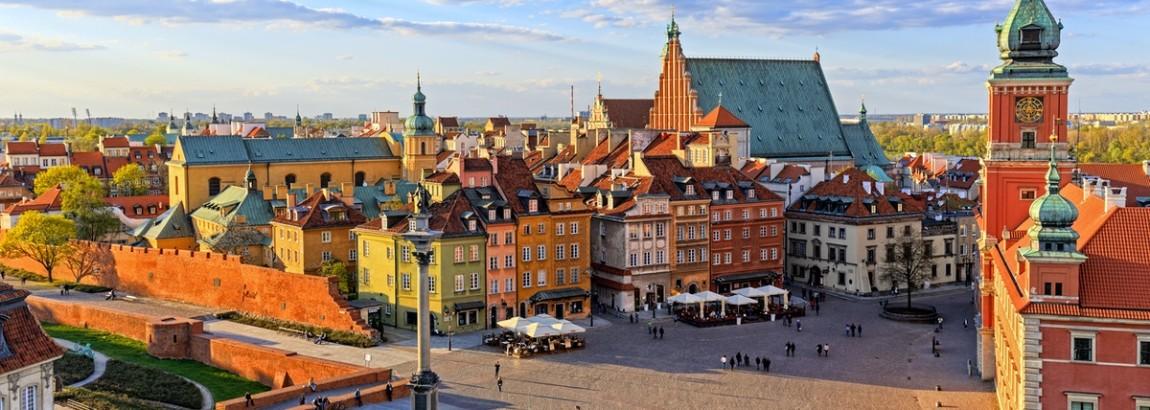
| City - Airport | Departure: | ||
| Iasi | Chisinau | ||
| to Warsaw (WAW) | IAS → WAW | RMO → WAW | |
| - Frederic Chopin (WAW) | IAS → WAW | RMO → WAW | |
After World War II, the city was rebuilt. So, for example, in the Old Town, behind carefully restored facades, apartments are modern according to the criteria of the post-war period with a completely different layout and equipment than their historical predecessors before 1939.
building in Warsaw. It is located in the city center on Paradov Square. Built on the model of the so-called "Stalin skyscrapers" as a gift from the Soviet Union to the Polish people. Today, the skyscraper serves as an office building and exhibition center, is the headquarters of a number of companies and government agencies. In addition, it houses museums, cinemas, theaters, restaurants, bookstores, swimming pools, scientific institutes and exhibition spaces.
Cathedral in the diocese of Warsaw-Prague of the Roman Catholic Church in the capital of Poland.
Construction was carried out from 1887 to 1904 according to the design of the architect Józef Pius Dziekoński. The cathedral was built in neo-gothic style. The interior is also decorated with brick texture in the Mazovian Gothic style. On a plinth in the right nave stands a Baroque statue of St. Florian.
architectural and historical monument located in Warsaw. The building, built in the style of baroque and classicism, is located at the address: Castle Square. Monument of national culture. The Royal Castle was built in 1598-1618 by the King of Poland. Included in the State Register of Museums. Originally the residence of the Mazovian princes.
is a science museum located on the banks of the Vistula River in Warsaw, Poland. The science center has more than 450 interactive exhibits, with the help of which visitors conduct experiments themselves. The Center is the largest institution in the field of scientific experiments in Poland and one of the most advanced in Europe. On September 25, 2012, the Center celebrated the visit of its two millionth visitor. The building of the Center was opened on November 5, 2010 and had five galleries.
the central and oldest part of the Old Town in Warsaw. It arose at the end of the 13th century, along with the foundation of the city. Historically, the town hall was located in the center of the square, the first mention of which dates back to 1429. For many years, the square played an important role in the life of the city, as the main center of trade, political performances and just a meeting place for Varsovians and guests of the capital.
the largest park in Warsaw, covering 76 hectares in the city center. The palace and park complex lies in the central city district, on Ujazdowska Alley, part of the "Royal Route" linking the Royal Palace in the center of Warsaw with the palace in Wilanów in the south. To the north of the park, on the other side of Agricola Street, stands the Ujazdowski Palace.
a large museum in Poland dedicated to the history of the Jewish community in this country. The museum opened in 2013. Located in Warsaw, on the territory of the former Warsaw Ghetto. The foundation stone of the museum was laid in 2007, the opening took place on April 19, 2013, on the 70th anniversary of the Warsaw Ghetto Uprising. The museum has a large interactive collection of exhibits dedicated to the thousand-year history of the Jews of Poland, up to the Holocaust.
a palace and a garden adjacent to it in the Wilanow district on the southeastern outskirts of modern Warsaw. Built in 1677-1698 by Augustin Lozzi for King Jan Sobieski. It is a masterpiece of the Baroque, as well as a subject of national pride of Poland.
barbican in Warsaw, which is one of the few surviving elements of the 16th century fortification complex that surrounded Warsaw. Located between the Old Town and the New Town, the barbican attracts the attention of numerous tourists. The barbican and ramparts are a favorite place for artists who sell their paintings here, as well as musicians and other street performers.
Museum, located in the building of the former tram power station. The museum was opened on July 31, 2004. The permanent exhibition covers an area of 3000 sq. m. and is located on 4 floors. Includes about 750 exhibits and 1000 photographs. The Museum of the Warsaw Uprising at the official level lays responsibility for the defeat of the Warsaw Uprising primarily on Joseph Stalin and the USSR. One of the basic ideas of the exposition is the “theory of two occupations”, Nazi and Soviet.
Airports:
Airports: